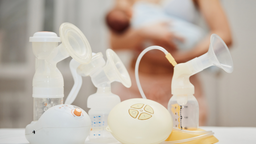No matter how breastfeeding unfolds for you in the early weeks, it’s normal to experience some challenges. We all do; breastfeeding is a learning process.
Every mom and baby are unique, and no two moms experience the same breastfeeding difficulties. Still, there are a few breastfeeding challenges that are pretty universal, and that many of us experience at least once as we begin breastfeeding.
Let’s take a look at the top 5 breastfeeding challenges— and most importantly, what you can do about them.
-
Nipple Pain
Not all mothers experience nipple pain when they first start breastfeeding, but it’s probably the most common breastfeeding challenge out there, with most mothers experiencing it to varying extents.
Many mothers are told that nipple pain is just something you should grin and bear. And while a gentle tugging on the nipple is usually fine as your body adjusts to your baby’s suckling, any kind of pain that lasts for more than a few seconds after latching — and indeed any pain that causes your nipple to look pinched, elongated, red, or causes broken skin — is something that should be addressed.
What You Can Do:
Most cases of nipple pain can be remedied by better positioning and deeper latching. If your baby is latched on deeply, their lips and mouth will be wide open (puckered, like a fish), and they will be taking in most of your areola. It can be useful to make sure your baby is well supported and lying belly-to-belly with you.
If you aren’t able to improve your baby’s latch alone, asking a lactation consultant for assistance can be so helpful! Sometimes improving latching and positioning don’t do the trick; in this case, your baby may have a suckling issue (sometimes caused by tongue-tie). Again, a lactation consultant or breastfeeding counselor can help you troubleshoot here.
If you are dealing with broken or chapped skin, applying lanolin-free Nipple Cream between feedings can really help heal the skin. It also ensures that your healing skin won’t scab.
-
Mastitis
When your breasts don’t properly drain, milk can get “trapped” in your milk ducts. The milk thickens and congeals, which can cause a painful lump in your breasts called a plugged duct. If that lump becomes infected, you may experience even more pain as well as flu-like symptoms (fever and chills). That is when you know you have mastitis — and yes, it can be just as awful as it sounds.
What You Can Do:
When mothers have mastitis, they are often afraid that their milk will somehow be bad for their baby, and then end up nursing less. But the milk is fine, and when you have mastitis, you actually want to nurse more so that you can drain your breast and unclog your plug.
Other remedies include nursing while massaging the plug, applying heat or cold to the affected area while nursing (whatever feels best), and varying your nursing positions. You shouldn’t be wearing tight bras, bras with underwire, or tight clothing during this time, as this can contribute to clogging and make things worse.
Sometimes an infection will clear up on its own just with extra nursing and other comfort measures. If your fever persists beyond 24 hours, it’s time to call your healthcare provider. Usually, a simple course of antibiotics will clear things up quickly.
-
Milk Blebs
If you have a small white or yellow spot on your nipple that is extremely painful and seems to be blocking your milk, you may be dealing with a nipple bleb or milk blister. This happens when a bit of skin grows over a milk opening in your nipple; you may notice that your milk feels backed right behind the bleb.
What You Can Do:
Blebs are often caused by poor latching, a badly fitting pump or pumping on a suction strength that is too high. Blebs are also sometimes caused by oversupply or excessive pressure on the breast or nipple. Correcting the underlying cause is an essential first step in clearing up a bleb.
Once you’ve identified the cause, there are a couple of measures you can take to remove and heal your bleb. Soaking with Epsom salts can be very helpful. Gently rubbing the bled with a washcloth can help break it up. Soaking a cotton ball in olive oil and then placing it in your bra on the bleb for a few hours may help as well.
You can also ask your healthcare provider to remove the bleb for you, or they may guide you in doing it yourself. After it’s been removed, you need to keep the healing area clean and sterile and apply nipple cream to keep the area moist and ensure that the bleb doesn’t scab over and possibly reappear.
-
Do I Have Enough Milk?
In the early days, as your milk comes in and you are establishing your supply, it’s reasonable to have concerns about whether you are making enough milk for your baby. After all, unlike with bottle feeding, you can’t tell how many ounces your baby is getting with each feed. It can feel so mysterious and may cause understandable worry.
What You Can Do:
During the first few days after birth, you will be producing colostrum, which is small in amount, but is full of dense nutrition and immune protectors — all your baby needs at first. Then, at about 3-5 days after giving birth, your breasts should become fuller, signaling that your milk is coming in.
Your baby likely lost a little weight after birth (some of this is fluids from birth), but after your milk comes in, your baby should begin gaining weight. Weight gain is one of the most reliable indicators that you are making enough milk for your baby. You can also use your baby's wet and poopy diapers as indicators that your baby is getting enough. After your milk comes in, your baby should have about 5-6 wet diapers per day and 3-4 poopy diapers.
Almost all moms produce enough milk for their babies, but some mothers do have milk supply issues. If you have any doubts about your milk supply, reach out. No question or concern is silly. A lactation consultant (IBCLC), or another healthcare provider can help you assess the situation. If your milk supply is indeed struggling in some way, there are so many things you can do to try to enhance it, including nursing more frequently, pumping, improving your baby’s latch, and adding nourishing foods and supplements to help give your supply more support.
-
Engorgement
Not all mothers experience engorgement when their milk comes in — and not experiencing it doesn’t mean you aren’t making enough milk! But some mothers become so engorged that breastfeeding and latching can be challenging for a few days.
Engorgement usually happens around the time your milk comes in. Your breasts may feel firm or even hard, and the fullness can even extend up into your armpits. The skin will look shiny and with visible veins, and often extreme engorgement will cause your nipples to flatten.
What You Can Do:
Engorgement usually passes in about 24 hours. But if your breasts are very sore and uncomfortable and if you are so engorged that your baby is having trouble latching on and you are having trouble emptying your breasts, it’s time to take measures to remedy things.
Massaging the breasts and hand expressing milk to soften the nipple before your baby latches on can work wonders. Cold packs or cold cabbage leaves between feedings can help with swelling. Apply heat to the breasts while massaging or hand expressing can get the milk flowing. The Reverse Pressure Softening protocol is a wonderful tool for relieving engorgement.
_________________________
So much is happening in those first few weeks as you find your groove with breastfeeding. Your hormones are changing rapidly; your milk supply is getting established; you are learning the ins and outs of latching; you’re getting into the rhythm of feeding, switching sides, reading your baby’s hunger cues, and so much more.
Be gentle with yourself if you encounter any bumps in the road. Remember we’ve all been there, help is out there for the taking, and before you know it, these breastfeeding challenges will be distant memories.



